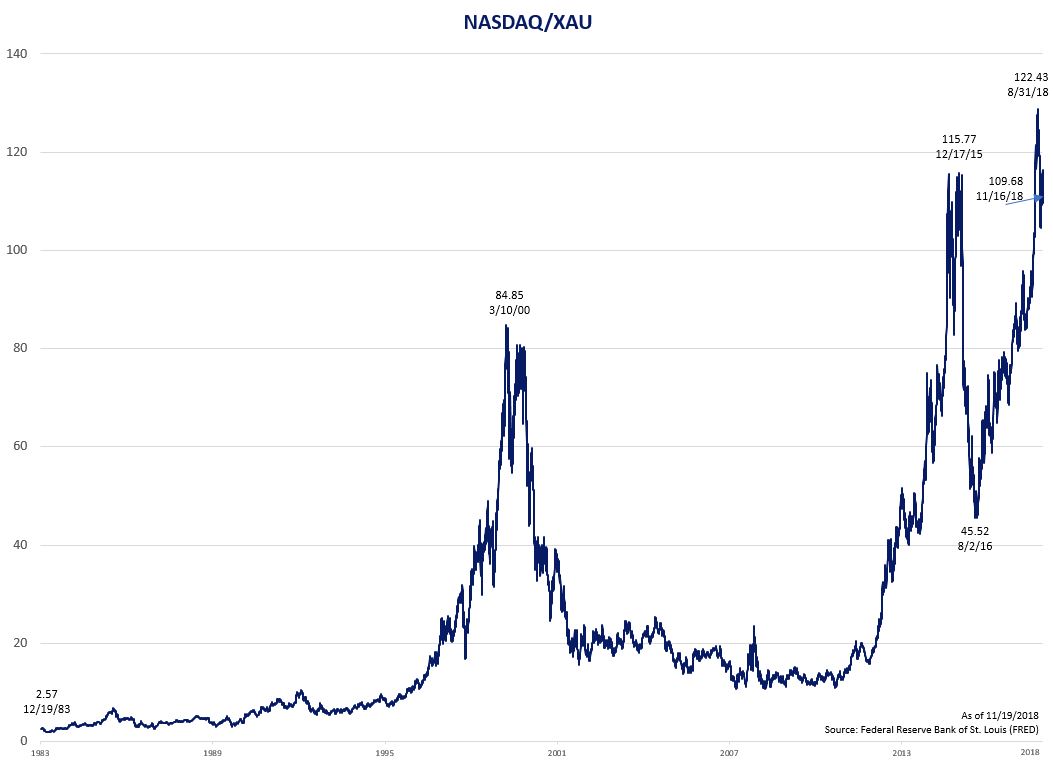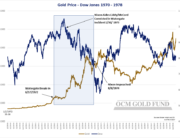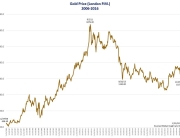December FOMC – Potential Gold Price Catalyst
The tone at the Federal Reserve is changing. Last week in a speech at the Dallas Fed, Chairman Jerome Powell acknowledged economic headwinds are mounting, such as slowing global demand and the lagging impact of past interest rate increases. A couple of days later, Vice Chair Richard Clarida echoed Powell stating slowing global growth could slow rate increases. Clearly, the boys are trying to put the message out that they will raise rates in December, but 2019 rate increases are now more of a wait and see proposition. By raising and pausing, Powell meets Trump halfway and gives the appearance that the Fed has some semblance of independence. Gold prices and most likely equity markets may view the pause favorably. The U.S. dollar not so much. At the end of the day, the Fed must error on the side of being overly accommodating and encourage inflation or risk deflating the entire credit bubble, in our opinion.
NASDAQ/XAU Ratio Peak?
The relationship between the Nasdaq Composite1 and the XAU2 is important, in our opinion. Major lows in gold mining shares have historically taken place around Nasdaq peaks. The ratio appears to be rolling over.
Everything Bubble Finally Bursting?
Bitcoin3, cannabis stocks, FANGs4, and housing are all giving way. The Fed’s triple tightening of raising rates, shrinking its balance sheet along with a stronger dollar appears to have hit an inflection point. History points to the bigger the bubble, the bigger the bust. A scary thought.
Poland, Hungary Join Central Bank Move to Increase Gold Holdings
Hungary added 28 tons to its official gold reserves in September 2018. The largest addition since Hungary added 45 tons in 1971 as Nixon was closing the gold window and its first purchases since 1986. Poland has made monthly purchases in July, August and September totaling 13 tons. The first purchases since 1997. India in September announced its central bank had purchased gold for the first time in nine years. Russia’s gold accumulation is well documented with 70% of its annual domestic production finding its way into Russia’s official reserves. The big question is why now? Clearly, International cooperation is waning pushing several central banks to position to trade away from U.S. dollar settlement mechanisms. Further, Russia and China appear to be positioning for a currency bloc based on gold.

Source: Kitco News
Federal Budget Deficit – $100 Billion per Month
Despite full employment and GDP5 growth of 3-4%, higher interest expense and contracting tax revenues related to tax reform has propelled the monthly federal deficit to $100 billion in October. These are the good times; in theory this should not be happening, but tax revenue is overwhelmed by interest on past debt issuance and aging demographic entitlement liabilities. Total Federal debt outstanding as of 11/15/2018 stood at $21.8 trillion. We expect total federal debt to continue its exponential path higher with the next economic downturn compromising U.S. fiscal position and consequently the U.S. dollar profoundly. Since Nixon closed the gold window in 1971, total federal debt outstanding and gold are correlated at 89.9%.
Source: Federal Reserve Bank of St. Louis (FRED)
OCM GOLD FUND Ex-Dividend Date
The OCM Gold Fund is anticipating paying a long-term capital gain distribution in December. The ex-dividend and payable date is December 21st.
7683-NLD-11/21/2018
Nasdaq1 is a global electronic marketplace for buying and selling securities, as well as the benchmark index for U.S. technology stocks.
XAU2 The Philadelphia Gold and Silver Index (XAU) is an unmanaged capitalization-weighted index composed of 16 companies listed on U.S. exchanges involved in the gold and silver mining industry. The index is generally considered as representative of the gold and silver share market.
Bitcoin3 is a digital currency created in 2009.
FANG4 is the acronym for four high-performing technology stocks in the market as of 2017 – Facebook, Amazon, Netflix and Google (now Alphabet, Inc.).
GDP5 is the gross domestic product (GDP) is the monetary value of all the finished goods and services produced within a country’s borders in a specific time period.
For more information or to schedule a call with Greg Orrell, Portfolio Manager, please call
1-800-779-4681.
Investors should carefully consider the investment objectives, risks, charges and expenses of the OCM Gold Fund. This and other important information about a Fund is contained in a Fund’s Prospectus, which can be obtained by calling 1-800-779-4681. The Prospectus should be read carefully before investing. Funds are distributed by Northern Lights, LLC, FINRA/SIPC. Orrell Capital Management, Inc. and Northern Lights Distributors are not affiliated.
The Fund invests in gold and other precious metals, which involves additional risks, such as the possibility for substantial price fluctuations over a short period of time and may be affected by unpredictable international monetary and political developments such as currency devaluations or revaluations, economic and social conditions within a country, trade imbalances, or trade or currency restrictions between countries. The prices of gold and other precious metals may decline versus the dollar, which would adversely affect the market prices of the securities of gold and precious metals producers. The Fund may also invest in foreign securities which involve greater volatility and political, economic, and currency risks and differences in accounting methods. The Fund is non-diversified, meaning it may concentrate its assets in fewer individual holdings than a diversified fund. Therefore, the Fund is more exposed to individual stock volatility than a diversified fund. Prospective investors who are uncomfortable with an investment that will fluctuate in value should not invest in the Fund.
Investments cannot be made in an index. Unmanaged index returns do not reflect any fees, expenses or sales charges.
Past performance is no guarantee of future results.





